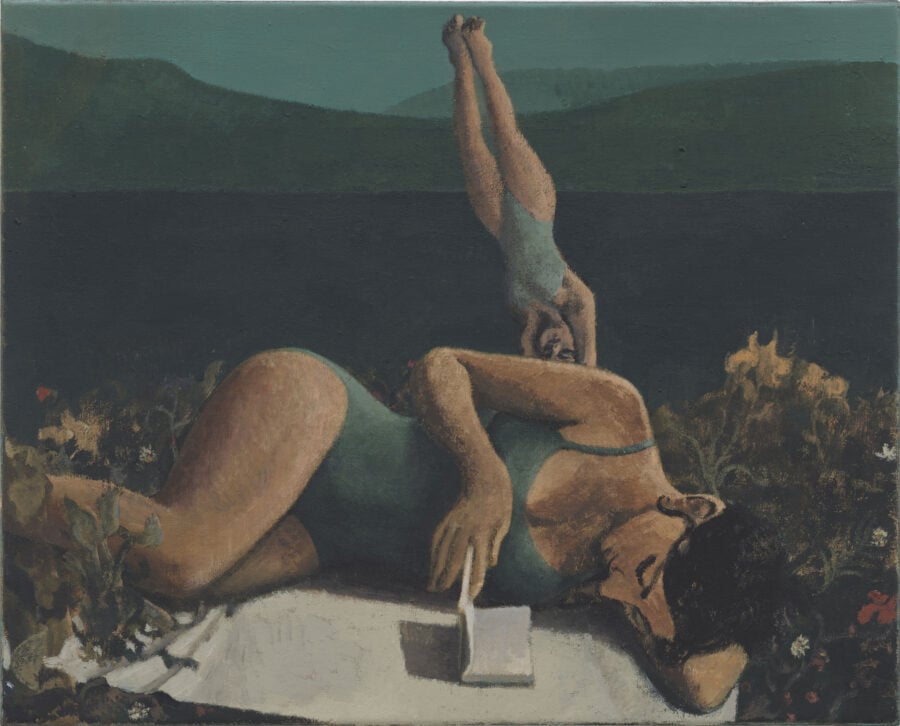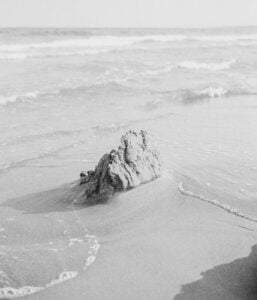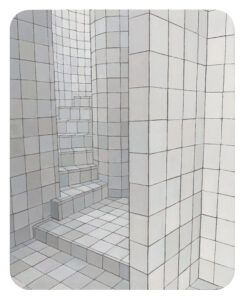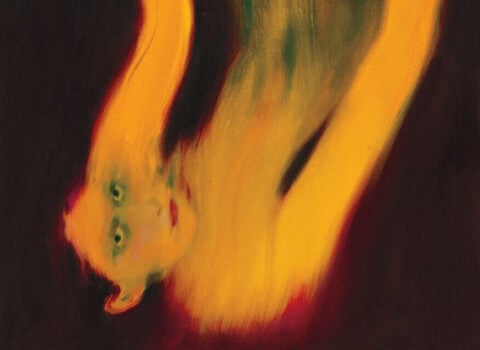
Beach Couple V, by Lenz Geerk © The artist. Courtesy the artist and Roberts Projects, Los Angeles
New Books
Something about poetry—writing it, reading it, writing about reading it—begs to be postponed indefinitely. I don’t mean that I dread it, only that it calls for conditions that never quite arise. My future, I imagine, needs poems more than my present does, because my future contains a more poetical me, someone attuned, observant, virtuous, vulnerable; or else someone ravaged and lusterless, inscrutable to himself, in need of spiritual realignment. I assume my life will improve or deteriorate dramatically, and in either case I’ll be ready for poetry. Part of the problem is that poems are held to be lapidary, which captures their compression but makes them too dear. If I thought of them as pressurized gas or flat-pack furniture, I might stop saving them for emergencies that never come.
Another solution is to turn the poems themselves into emergencies. Call this the English-major approach: by charging tuition, dangling the promise of a B.A., and arranging a series of hard deadlines, you can compel students to read dozens—maybe even hundreds—of poems in a few years. This will color their approach to poetry for the rest of their lives, and not always for the better, but at least it keeps the work in circulation. Annabel Percy, the cosseted Oxford undergrad of Rosalind Brown’s debut novel, Practice (Farrar, Straus and Giroux, $26), has an essay due on Shakespeare’s sonnets. She’s the kind to take such things seriously—the sonnets “offer themselves like small jewels,” she feels—but not so seriously that she hasn’t waited until the last minute to get to work. She spends the bulk of Practice holed up in her room on a dreary winter Sunday, grasping for a fresh take on some of the most widely read verses in history. It’s 2009, so it’s socially acceptable for her to turn off her phone, but even this does not help her focus. To ascend the sheer wall of a sonnet, with all its negative space on the page, “requires an ice pick and a hot thermos,” she thinks. “Each one seems to annul the previous one. . . . They dissolve into a mass of little qualifications and turns and particularities and withholdings and accusations and escapes.” She’s hindered not by their irrelevance but by their teeming aliveness; the sonnets conform to her shape “willingly, but still lightly, like a duvet does.”
She has run up against the great impediment to undergraduate scholarship: the ridiculous expectation for a nineteen-year-old to read love poems as anything other than a comment on her own love. All assigned reading will reflect her here and now. Every syllabus will become a referendum on her sex life. Annabel’s has a hint of Shakespearean indiscretion. She’s secretly dating a thirty-six-year-old friend of her mother’s who wants to visit the next weekend and needs an answer. She would prefer to banish him from her thoughts until the essay’s done, but unfortunately, “nothing in even the best of the Sonnets can convincingly replicate the sensation of being fucked by him.” Not quite what W. H. Auden had in mind when he wrote that “poetry makes nothing happen,” but perhaps it should have been.
If Practice were a lesser novel, it would amount to a close reading of Shakespeare in the gauzy red light of an illicit romance. But it’s too discursive for that, and too shrewd; it’s more concerned with the inner life of someone who’s hoping not to have one, if only for a few quiet hours. True poetic insight, Annabel thinks, sometimes requires blinkering your mind and ignoring your body. She sets a monastic standard: “no touching her hair or crossing or uncrossing her legs or murmuring to herself.” Emptying her bladder is a treat, and a glass of water is ecstasy. “Sometimes she can’t wait to get off the toilet and flush so she can neck some more water,” Brown writes. “Where the thinking is supposed to happen, how anyone can think in these conditions, is a mystery.”
Does thinking while you’re horny still count as thinking? This is where Annabel is most fecund. Masturbation, at least as she practices it, is a reliable engine of literary production, just as literature is a reliable engine of masturbation. The sonnets goad her toward intricate fantasies, though every indication suggests that she would have found them on her own. She imagines two men, a scholar and a seducer, pursuing each other through years of aching homoerotic tension—the seducer wears fine, silk-lined gloves and peels apples with a thin silver knife, while the scholar says catty things like “aphrodisiacs are the only plants you seem to know about.” And she conjures a dream lover she calls “the green man,” who lives in the woods beside a scum-covered pond. He falls somewhere between Christian Grey and the gamekeeper from Lady Chatterley’s Lover:
He makes his own exquisite implements. A white china doorknob he found and fixed to a buckled strap. The strap goes around her head, the cold doorknob into her mouth. Also a cage for the tongue: he likes to push his own tongue in and feel her squashed and straining behind the thin twiggy bars of the cage. Also a gag which can be stuffed with herbs before being fitted. Her full mouth, a fragrant speechlessness. He surveys her: I like to see you munching on my herbs. This line took her surging over the edge and drained her so completely she couldn’t move for fifteen minutes afterwards.
“I like to see you munching on my herbs”: this is a sui generis contribution to the language of climax, and it’s in iambic pentameter, a perfect fit for the mouth of a sonnet. Its oddity speaks to the saving grace of Practice, which is, on the surface, a precious novel. Annabel sips tea, does yoga. Oxford for her entails long walks, misty treetops, dark corners to kiss in, cheeky little snacks in her pyjamas. She glimpses her full interior only under the weight of procrastination, which compresses her most honest thoughts into poems. Shakespeare’s sonnets hardly matter amid all this, and her essay matters even less, but she couldn’t get anywhere without them. Brown has delicately articulated one of the less-discussed pleasures of reading: a kind of anti-reading, a momentum that gathers not in spite of distraction but because of it.

Look Between the Rain, by Mary Herbert © The artist. Courtesy the artist and Moskowitz Bayse, Los Angeles
Annabel knows she’s not a “natural scholar” because whenever “she tries to tame her choppy mind . . . bits of foam come flying off the surf.” But Yoko Tawada’s novel Paul Celan and the Trans-Tibetan Angel (New Directions, $14.95) follows an actual scholar of poetry, a Berliner named Patrik, who has the same complaint: he’s thwarted by his “thought-foam,” a thick layer of which obscures his understanding of the German-language poet Celan. “There’s no need to be ashamed of foam,” his friend reassures him. “What would a life without foam look like? Foam protects my skin from the razor blade, it keeps my cappuccino warm and my beer fresh.” But Patrik’s is no ordinary foam. It’s made of raw poems—it’s disgusting. This “dense mass of unconnected words” clogs “not only his brain but even the little hairs in his eyebrows and eyelashes. . . . His stomach is full of words he finds he cannot digest.” Next to Practice, Tawada’s book reads almost like a cautionary tale for Annabel: this is what happens if you devote your life to poetry. Do not go pro.
Patrik has a handsome post at a research institute, and he’s supposed to prepare a conference talk about Celan’s collection Threadsuns, published in 1968, about two years before the poet plunged to his death in the Seine. (Don’t worry if you haven’t heard of it; it wasn’t available in English until the early 2000s.) Like Annabel, Patrik manages to while away the whole novel without putting pen to paper. His feeling is that an academic conference is no place for poetry—even if the conference is about poetry. “I don’t like questions, criticism, or discussion,” he says.
I usually construct a conference paper as lovingly as you would build a sandcastle at the beach. I don’t understand why most children are so cruel they want to destroy my sand art with their toy shovels.
What a sensitive guy. You can see how poems have nourished his soul. Patrik likes to call himself “the patient,” though his therapist committed suicide some time ago, leaving him to conduct his life in an obsessive-compulsive haze. The novel flickers between the first and third person, which furthers one’s sense that he’s not the picture of mental health. He turns left whenever he leaves the house, shaves his head just because, and counts the letters in any word that pertains to his body, a form of “private mysticism.” “His testes, for example, which had six letters, fit neither in his pants nor his brain, where there was only room for five,” Tawada writes.
For a while, Celan’s poems are Patrik’s only confidants. His girlfriend is long gone. A mysterious stranger, the trans-Tibetan angel of the title, lifts his spirits by seeking him out at a café with a gift: a German medical text that Celan once annotated on his quest for new language. “Here are the words brainstem and cerebral cortex,” the angel says. “This is the book Celan read as a psychiatric patient”: music to Patrik’s ears. He never fully explains his fascination with the poet, but it’s risen to a feeling of kinship, and it’s bound up in words. Celan built a precarious, phantasmal vocabulary (“shadowjoints,” “disnighted”) from the wreckage of the Holocaust, and Patrik wants to speak it fluently, even exclusively. “Traditional words” stick in his craw. “The word kissing, for example, tastes like dill pickle salad.” Celan’s coinages are a refuge. Susan Bernofsky, who has translated Tawada beautifully from the German, writes in an afterword that Celan “is known for the diamond-hard density of his lyrical lines”—poetry as applied pressure. Patrik argues that Celan endured this pressure even as it squeezed his own voice out of him, folding him “into a space of art too narrow to admit an I.”

A photograph by Jošt Dolinšek from his series To Move the Sun and Earth Away © The artist. Courtesy Photon Gallery
This novel, too, barely admits an I, even this reader’s I. It’s almost a Celan smoothie: icy, sweet, and, of course, foamy, a little treat from the tart fruits of the poet’s labor. You could walk around the mall with it. It coats your tongue, numbs your hand, and soon you have to pee, and it’s all very nice, and then it’s over. Tawada has smuggled tons of Celan references into it (or so Bernofsky writes; most of them were lost on me), and Patrik himself is less a character than a vehicle for Celanian debris.
The book is a pandemic novel, which is never addressed directly—but it explains why so many buildings are closed, and why Patrik’s desire for connection has a hysterical, unresolved urgency. Motivation seizes and then immediately abandons him, much as Celan struggled to make meaning:
Time to arise, collect oneself, and vertically enter the outside world! That’s all the first voice in Threadsuns asks. Life can be as transparent as a poem. Arise and collect yourself! Am I truly awake, or am I just moving from the first act to the second in an ancient dream? Who’s the conductor here? Who’s the composer? Who rules? You have to be the ruler of your own life. This strikes the patient as all but impossible.
Tawada floats the possibility that Patrik has been dead the whole time, having perished in a plane crash en route to his conference in Paris. It is, indeed, hard to be the ruler of your own life if it has ended. So he’s in limbo now, an island of repose and nonsense; kind of sad, but a good place to settle down with all the poems, finally. “Earth is already populated with the dead,” he tells the angel, with an air of haunted authority. “Their songs aren’t always beautiful, but they’re certainly worth listening to.”
The reader who learns to seek out poetry, rather than keep it forever at arm’s length, may soon believe that it should be everywhere—that it is everywhere. I felt a bit like Patrik poring over Celan’s medical textbook as I made my way through Private Spaces in Public Places (Johns Hopkins University Press, $59.95), a collection of “spatial case studies” by Laura Walikainen Rouleau about the nation’s early comfort stations, fitting rooms, public baths, locker rooms—all those tawdry, tucked-away places where the middle class could bare themselves without exposing themselves, as public life became more crowded and various. I was curious about the history of our restrooms, yes (I love restrooms), but I also had a hunch that there was poetry somewhere in these pages, even amid such sentences as “Note the inclusion of individual doors to each of the women’s tub rooms.”
Would I find it in Calumet, Michigan? In the basement of a public library there, a mining company opened a bathhouse. a boon to the community: the big corporations are certainly not soulless, one newspaper proclaimed. The workers could bathe and read, which was thought to “inspire sweeter manners and better observance of law.” Men and boys could swim naked. Women had to wear bathing suits, and attendants wore full suits: Rouleau includes an archival photo, from one of Calumet’s indoor pools, in which a man stands in coat and tie watching the swimmers take their pleasure. He looks stolid, his jacket heavy in the humidity. This is a poem.

O místico (The Mystic), 2005, oil on canvas, by Adriana Varejão © Adriana Varejão. Courtesy the artist and Gagosian
The phrase “comfort station” is a poem, too. Now a genteelism, it promises an oasis of relief that no American in his right mind would expect to find in a public lavatory. Reformers were proud of the first restrooms: these were accommodations, monuments to the new hygiene. “The designers and creators of these private spaces sought to materially impose their hygienic ideals,” Rouleau writes. She quotes an engineer who asserted that “pure white glazed earthen fixtures set in pure white compartments foster a feeling of decency and aid in inducing cleanly habits.” (Practice’s Annabel, high in her ivory tower, also finds a salubrious poetry on the toilet, where “she has put a great thaw down through her river-system, of water and peppermint tea, a torrent carrying along all her splintered boughs of trees and chunks of ice.”) A monthly paper called, poetically, Sanitary Pottery advised that an ideal stall should be large enough to permit “hot and dirty travelers” to take “a refreshing sponge bath.” Finding similar stalls in the New York of the 1890s, gay men immediately began to use them for sex. This was poetic as well.





